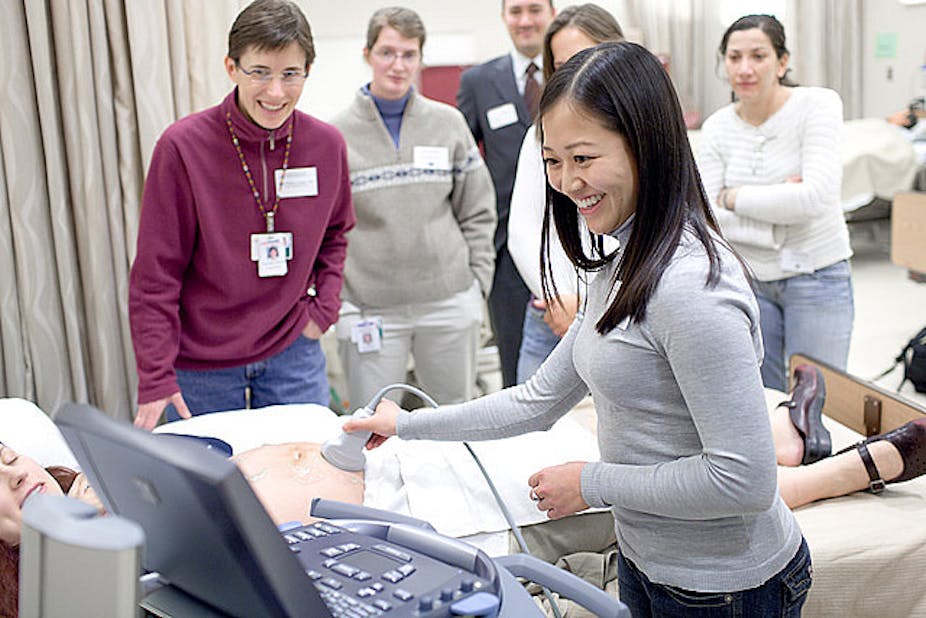In an attempt to bring Australia’s medical research, education and healthcare sectors into line with world leaders, the National Health and Medical Research Council (NHMRC) is planning to develop a new type of institution in Australia: the Advanced Health Research Centre (AHRC).
The NHMRC’s plans are in the very early stages, with a discussion paper released late last year to gauge the views of health and medical research community. We’re now awaiting the results of these discussions.
How will these centres work?
These centres are expected to be based on the United Kingdom’s Academic Health Science Centres (AHSC).
The idea is to create a partnership between a large hospital (or group of hospitals), a university and associated medical research institute(s).
The AHRC will be responsible for the translation of advances in medical research into clinical practice, day-to-day care of patients and training of health professionals.
The aim of the new institutions is to provide better coordinated care for patients. It’s also important that these centres provide primary care to keep patients healthy and out of expensive hospital-type care.
How did the model develop in the UK?
Three years ago the United Kingdom’s National Health Service (NHS) called for universities, teaching hospitals, health research institutes and the primary care organisations to tender to establish Academic Health Science Centres.
The NHS received more than 20 applications and after an international review process, chose to develop five centres.
They were based on the same objective as above, with the added concern that British leadership in medical research had been overtaken, to some extent, by the Americans and they needed to catch up with a bold new institutional framework.
Rather than increase government funding to develop these centres, a very clear directive was made: no “new” funds would be used. Instead, these partnerships have a greater chance of obtaining government and industry funding for research.
So how did they go? A review will evaluate the processes and outcomes next year but so far reports from participants have been positive.
Where else are they operating?
A slightly different model of Academic Health Centre has been operating in the United States for around 20 years. Universities own hospitals and health services, and hospitals can establish their own academic and research programs as university affiliations.
This model has been very successful in universities like Stanford, Duke and Boston, where the institution provides public health care to the community.
There are other models as well; the successful Mayo and Cleveland Clinics are based on private health care institutions.
Academic Health Science Centres also operate in Holland and Sweden and many medical schools, health science faculties and teaching hospitals around the world espouse the principles of this type of institution.
Why do we need them?
Australia has one of the most fragmented health systems in the world, driven by many different funding agencies (state, commonwealth and private) and outcome drivers.
For universities, outcome drivers might be student numbers, research outputs, grants and published papers.
For health service providers, outcome drivers are likely to be numbers of patients seen, procedures carried out, timeliness and quality of care.
We have a health system that consumes over $100 billion dollars every year and this is rapidly rising. According the the Productivity Commission’s report on Australia’s Health Workforce, inefficiency within the health system is as high as 20%.
So there is a clear economic incentive to see where savings can be made.
What are the upcoming challenges?
The most important element of the Advanced Heath Centres is how are they going to “govern” themselves (the UK model was not prescriptive). The Centres should be left to create their own model of governance that fits with their particular organisational structure and their aspirations.
In any partnership it’s important to create a shared vision. But each player also has to cede something for the greater good. So it will be interesting to see what level of autonomy these groups – universities, hospitals, research institutes – are willing to give up.
Another challenge will be to create these institutions without additional funds. This will be an important incentive to find money which is already in the “system” and spend it more wisely
Advanced Health Science Centres have a real opportunity to bring together disparate elements of our health system and take it to the next level. I hope the health professions will see this opportunity for what it is.

